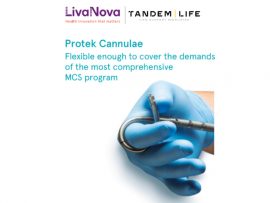Abstract Left ventricular assist devices (LVAD) have improved mortality and quality of life for patients with end-stage heart failure by providing an alternative to cardiac transplant or as a bridge..
Read MoreAbstract Introduction: In remote hospital settings, providing timely and effective extracorporeal cardiopulmonary resuscitation (ECPR) is challenging due to infrastructure limitations and accessibility issues. We are highlighting the importance of grab-and-go ECPR..
Read MoreAbstract Background: Acute right ventricular failure is a critical complication after left ventricular assist device (LVAD) implantation, often managed with a temporary paracorporeal right ventricular assist device (RVAD). This study..
Read MoreAbstract Heart transplantation and left ventricular assist devices (LVADs) have emerged as crucial interventions for end-stage heart failure, dramatically improving patient outcomes. This narrative review examines their historical context, indications,..
Read MoreAbstract Patients on left ventricular assist devices (LVAD) are prone to excessive hemostasis disturbances due to permanent contact of artificial pump surfaces with blood components. We aimed to investigate if..
Read MoreAbstract Background Patients requiring biventricular support (BIVAD) face higher morbidity than those undergoing durable left ventricular assist device (LVAD) implantation alone. The goal of the current study was to evaluate..
Read MoreAbstract Right heart failure (RHF) management after left ventricular assist device (LVAD) implantation includes inotropes, right ventricular mechanical support, and heart transplantation. The purpose of this study is to compare..
Read MoreAbstract Objectives Right ventricular failure following implantation of a durable left ventricular assist device (LVAD) is a major driver of mortality. Reported survival following biventricular (BiVAD) or total artificial heart..
Read MoreAbstract Background The efficacy of extracorporeal membrane oxygenation (ECMO) as a bridge to left ventricular assist device (LVAD) remains unclear, and recipients of the more contemporary HeartMate 3 (HM3) LVAD..
Read MoreAbstract Introduction: The need for preoperative extracorporeal membrane oxygenation (ECMO) support prior to left ventricular assist device(LVAD) therapy has been associated with increased mortality. Our study investigated the impact of de-escalating..
Read MoreAbstract Summary The importance of temporary mechanical circulatory support for treating acute heart failure with cardiogenic shock is increasingly recognized, and Impella (Abiomed, Danvers, MA, USA) has received particular attention..
Read MoreAbstract With the implementation of the new allocation system in the United States on October 18, 2018, patients requiring temporary mechanical circulatory support (tMCS) have the highest priority, a shorter..
Read MoreAbstract Left ventricular assist device (LVAD)–induced hemodynamics are characterized by fast-moving flow with large variations in velocity, making quantitative assessments difficult with existing imaging methods. This study demonstrates the ability of..
Read MoreAbstract Background Modern left ventricular assist devices (LVAD) have evolved to become standard of care in severe heart failure (HF) patients. Right HF (RHF) is a major complication responsible for..
Read MoreBy Stephanie Louka, MD Case scenario: Paramedics are called to the home of a 59-year-old male patient with an LVAD who was found unconscious and unresponsive by family members. He..
Read MoreAbstract CentriMag® extracorporeal VAD support could represent a more physiological choice than conventional ECMO in primary cardiogenic shock. We therefore evaluated the outcome of patients with primary cardiogenic shock who were..
Read MoreAbstract Importance Intravascular microaxial left ventricular assist device (LVAD) compared with intra-aortic balloon pump (IABP) has been associated with increased risk of mortality and bleeding among patients with acute myocardial infarction..
Read MoreAbstract Left ventricular assist devices (LVADs) are safer and provide better survival and better quality of life than biventricular assist devices (BVADs) but end-stage heart failure often involves both ventricles,..
Read MoreAbstract Importance Although durable left ventricular assist device (LVAD) therapy has emerged as an important treatment option for patients with advanced heart failure refractory to pharmacological support, outcomes, including survival, beyond..
Read MoreAbstract Left ventricular assist devices (LVADs) have been increasingly used as a therapy for patients with end-stage heart failure. However, a growing number of clinical observations have shown that LVADs..
Read MoreAbstract Objectives Peripartum cardiomyopathy (PPCM) is a form of systolic heart failure occurring toward the end of pregnancy or in the period after delivery. Lack of myocardial recovery or therapy‐refractory..
Read MoreAbstract Many centers reported positive outcome after left ventricular assist devices (LVADs) implantation using a minimally invasive approach. The main drawback of this minimally invasive approach is the feasibility of..
Read MoreAbstract The field of left ventricular assist devices (LVADs) witnessed an important boost after the introduction of the third-generation durable mechanical circulatory support devices. Among the technical improvements which contributed..
Read MoreAbstract (LVADs) improve symptoms and outcomes in advanced heart failure. Although device malfunction has decreased significantly with later generation LVADs, it has not been eliminated. We describe the clinical course..
Read MoreAbstract Over the past decade, continuous-flow rotary pumps have dramatically improved survival for patients with advanced . Bleeding and thrombosis, however, continue to be the Achilles heel of (LVAD) therapy. There is..
Read MoreAbstract Quality problem or issue The traditional variable life-adjusted display (VLAD) is a graphical display of the difference between expected and actual cumulative deaths. The VLAD assumes binary outcomes: death..
Read MoreAbstract Pump thrombosis and stroke are serious complications of left ventricular assist device (LVAD) support. The aim of this study was to test the ability of an accelerometer to detect..
Read MoreBackground Recent data suggest that contributes to (LVAD) , but the mechanism is unknown. In a clinical study, we measured plasma free hemoglobin (pfHgb) and the incidence of LVAD thrombosis. In an in..
Read More











